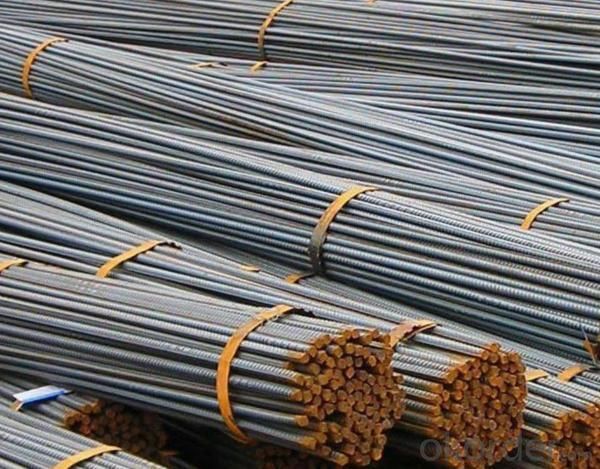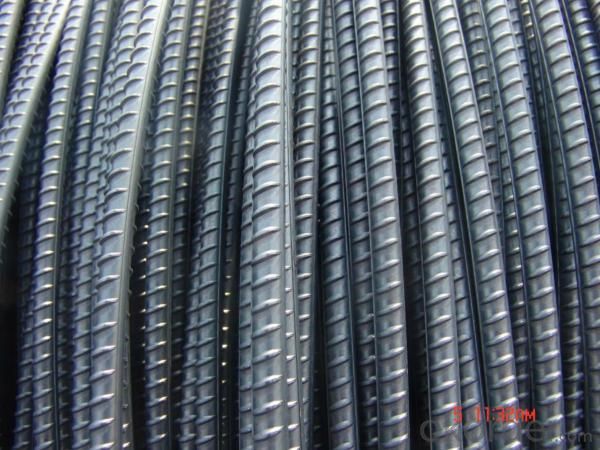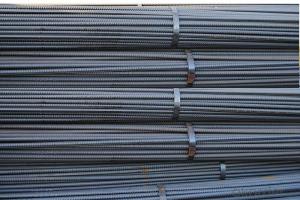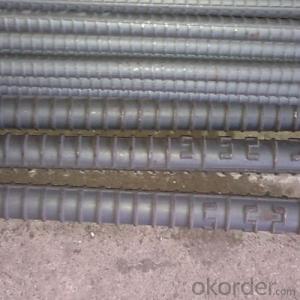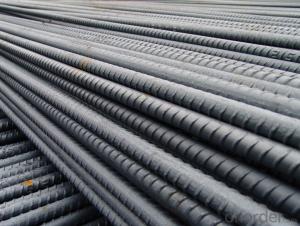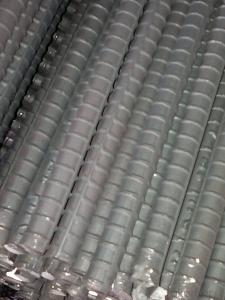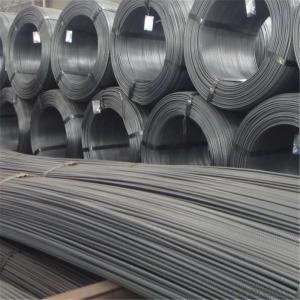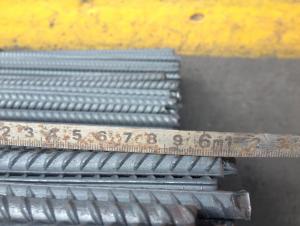Steel Rebar
- Loading Port:
- China Main Port
- Payment Terms:
- TT or L/C
- Min Order Qty:
- 50Tons m.t.
- Supply Capability:
- 1000 Tons Per Day m.t./month
OKorder Service Pledge
OKorder Financial Service
You Might Also Like
Specifications of Steel Rebar:
Standard | GB UK USA | HRB335 HRB400 HRB500 G460B, B500A, B500B,B500C GR40, GR60 | |
Diameter | 6mm,8mm,10mm,12mm,14mm,16mm,18mm,20mm, 22mm,25mm,28mm,32mm,36mm,40mm,50mm | ||
Length | 6M, 9M,12M or as required | ||
Price | Keep lower operating costs so as to offer competitive price for our clients | ||
Label | to be specified by customer, generally, each bundle has 1-2 labels | ||
Application | Building, construction | ||
Invoicing | Actual or Theoretical Weight Basis as buyer’s request. | ||
Type | Hot rolled steel rebar | ||
Brand name | DRAGON | ||
Theoretical weight and section area of each diameter as below for your information:
Diameter(mm) | Section area (mm²) | Mass(kg/m) | Weight of 12m (kg) | Pcs/ton |
6 | 28.27 | 0.222 | 2.664 | 375.38 |
8 | 50.27 | 0.395 | 4.74 | 210.97 |
10 | 78.54 | 0.617 | 7.404 | 135.06 |
12 | 113.1 | 0.888 | 10.656 | 93.84 |
14 | 153.9 | 1.21 | 14.52 | 68.87 |
16 | 201.1 | 1.58 | 18.96 | 52.74 |
18 | 254.5 | 2.00 | 24 | 41.67 |
20 | 314.2 | 2.47 | 29.64 | 33.74 |
22 | 380.1 | 2.98 | 35.76 | 27.96 |
25 | 490.9 | 3.85 | 46.2 | 21.65 |
28 | 615.8 | 4.83 | 57.96 | 17.25 |
32 | 804.2 | 6.31 | 75.72 | 13.21 |
36 | 1018 | 7.99 | 98.88 | 10.43 |
40 | 1257 | 9.87 | 118.44 | 8.44 |
50 | 1964 | 15.42 | 185.04 | 5.40 |
Steel Rebar in warehouse

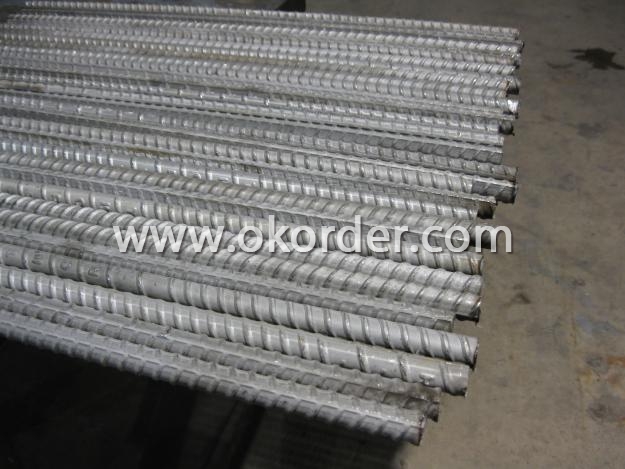
Chemical Composition: (Please kindly find our chemistry of our material based on BS4449 as below for your information)
BS4449 G460B | Chemical Composition | ||||
C | Mn | Si | S | P | |
0.18 | 0.35 | 0.14 | 0.025 | 0.25 | |
Physical capability | |||||
Yield Strength(N/cm²) | Tensile Strength(N/cm²) | Elongation (%) | |||
625 | ≥460 | 18 | |||
Usage and Applications of Steel Rebar:
Deformed bar is widely used in buildings, bridges, roads and other engineering construction. Big to highways, railways, bridges, culverts, tunnels, public facilities such as flood control, dam, small to housing construction, beam, column, wall and the foundation of the plate, deformed bar is an integral structure material. With the development of world economy and the vigorous development of infrastructure construction, real estate, the demand for deformed bar will be larger and larger..
Packaging & Delivery of Steel Rebar:
Packaging Detail: products are packed in bundle and then shipped by container or bulk vessel, deformed bar is usually naked strapping delivery, when storing, please pay attention to moisture proof. The performance of rust will produce adverse effect.
Each bundle weight: 2-3MT, or as required
Payment terms: TT payment in advance or Irrevocable LC at sight.
Trade terms :FOB, CFR, CIF
Delivery Detail: within 45 days after received advanced payment or LC.
Note:
1. Our products are produced according to national standard (GB), if not, supply according to national standards (GB) or agreement as customer required.
2. Other Grade and Standard Deformed Steel Bar we can supply:
Grade: GR40/GR60, G460B/B500A/B500B/B500C,BST500S
Standard: ASTM, BS, DIN
The Minimum Order Quantity of these products is high, and need to be confirmed.
3. We can not only supply Deformed Steel Bar; if you need anything about building materials, please contact us for further information.
4. Please send us your detail specifications when inquire. We will reply to you as soon as possible. We sincerely hope we can establish a long stable business relationship.
- Q: What is the role of steel rebars in preventing shrinkage cracks in concrete?
- Steel rebars play a crucial role in preventing shrinkage cracks in concrete. Shrinkage cracks occur in concrete due to the natural drying and curing process, as the water content in the concrete evaporates and the material contracts. These cracks can compromise the structural integrity and durability of the concrete. The inclusion of steel rebars in concrete helps to mitigate shrinkage cracks by providing tensile strength. While concrete is strong in compression, it is weak in tension. During the drying process, the rebars act as reinforcement, resisting the tensile forces that develop as the concrete shrinks. This prevents the formation and propagation of shrinkage cracks. The rebars act as a framework or skeleton within the concrete, distributing the tensile stresses and preventing them from concentrating in one area. By restraining the shrinkage of the concrete, the rebars help to maintain the overall integrity and stability of the structure. In addition, steel rebars also enhance the overall strength and load-bearing capacity of the concrete. By adding reinforcement, the concrete becomes more resistant to bending, shearing, and other forces that can lead to cracking. Furthermore, the presence of rebars in concrete also helps to control the width and depth of any cracks that may still occur. By confining and limiting the size of cracks, the rebars prevent them from expanding and potentially compromising the structural integrity of the concrete. In summary, steel rebars play a crucial role in preventing shrinkage cracks in concrete by providing tensile strength, distributing the stresses, enhancing overall strength, and controlling the size of cracks. Their inclusion in concrete ensures a more durable and reliable structure, minimizing the risk of damage and maintaining the longevity of the concrete.
- Q: Can steel rebars be used in earthquake-resistant buildings?
- Yes, steel rebars can be used in earthquake-resistant buildings. Steel rebars are commonly used in construction to reinforce concrete structures, providing strength and durability. In earthquake-resistant buildings, steel rebars are strategically placed to distribute and absorb the seismic forces generated during an earthquake, preventing structural failure and reducing the risk of collapse. This reinforcement helps to enhance the overall stability and resilience of the building, making it more resistant to seismic activity.
- Q: Are there any international standards for steel rebars?
- Yes, there are international standards for steel rebars. The most widely recognized standard is the ISO 6935-2:2015, which provides specifications for steel bars used in reinforced concrete structures. Additionally, other standards like ASTM A615/A615M (USA), BS 4449 (UK), and DIN 488 (Germany) are also commonly followed for steel rebars. These international standards ensure the quality, strength, and durability of steel rebars used in construction worldwide.
- Q: How do steel rebars contribute to the overall durability and service life of concrete structures?
- Concrete structures benefit from the inclusion of steel rebars in several ways, contributing to their overall durability and service life. To begin with, steel rebars are utilized in concrete structures to bolster their tensile strength. While concrete is strong under compression, it lacks strength when subjected to tension. Incorporating steel rebars, which possess high tensile strength, into the concrete significantly increases the overall strength and load-bearing capacity of the structure. This enables the structure to withstand external forces such as wind, earthquakes, or heavy loads, thereby reducing the risk of structural failure and enhancing its overall durability. Additionally, steel rebars play a vital role in preventing cracking and controlling the spread of cracks within concrete structures. As concrete dries and undergoes temperature fluctuations, it has a tendency to shrink and crack. The presence of steel rebars helps to distribute these forces and stresses throughout the structure, minimizing the formation and expansion of cracks. By restricting the propagation of cracks, the rebars contribute to the overall structural integrity and longevity of the concrete structure. Moreover, steel rebars offer reinforcement against corrosion. Concrete possesses high alkalinity, which generates a protective layer known as the passivation layer around the steel rebars. This layer safeguards the rebars from rusting and corroding when exposed to moisture or aggressive chemicals. By preserving the integrity of the rebars, the overall durability and service life of the concrete structure are enhanced. Furthermore, steel rebars are instrumental in improving the structural stability and resilience of concrete structures. By providing reinforcement and rigidity to the concrete, they aid in the even distribution and dissipation of applied loads and stresses. This diminishes the likelihood of localized failure and augments the structure's capability to withstand external forces and deformations. The presence of steel rebars also enhances the structural behavior of the concrete, rendering it more resilient to dynamic forces such as vibrations or impacts. In conclusion, steel rebars make a significant contribution to the overall durability and service life of concrete structures. They enhance the tensile strength of the concrete, prevent cracking and control the propagation of cracks, provide reinforcement against corrosion, and improve structural stability and resilience. By integrating steel rebars into concrete construction, engineers can create robust and long-lasting structures capable of withstanding various challenges, ensuring the safety and longevity of the built environment.
- Q: What are the common types of steel rebars used in bridge construction?
- The common types of steel rebars used in bridge construction are typically hot-rolled, deformed, and epoxy-coated rebars.
- Q: Can steel rebars be used in structures with limited construction space?
- Yes, steel rebars can be used in structures with limited construction space. Steel rebars are versatile and can be easily maneuvered and placed in confined spaces. They are commonly used in construction projects with limited space, such as high-rise buildings, underground structures, and bridges. Their flexibility and strength make them a suitable choice for reinforcing concrete structures in tight construction areas.
- Q: What are the different types of steel rebars used in airport construction?
- To ensure the durability and structural integrity of airport infrastructure, a variety of steel rebars are utilized in airport construction. Airport construction commonly employs the following types of steel rebars: 1. Mild Steel Rebars: These rebars, made from carbon steel with a smooth surface, are the fundamental and widely used reinforcement in airport construction. They provide general reinforcement and are applicable to airport runways, taxiways, and aprons. 2. High Strength Deformed (HSD) Steel Rebars: HSD rebars undergo a heat treatment process, enhancing their strength and ductility. These rebars have ribbed surfaces that adhere better to concrete, making them ideal for critical structural elements like beams, columns, and foundations in airport construction. 3. Epoxy-Coated Rebars: For environments prone to corrosion, epoxy-coated rebars are employed. These rebars have an epoxy resin coating that shields the steel from moisture and chemicals in concrete. Epoxy-coated rebars are frequently used in airport construction, particularly in areas exposed to corrosive substances and de-icing salts. 4. Stainless Steel Rebars: Stainless steel rebars possess excellent corrosion resistance and are commonly utilized in coastal airports or high-humidity regions. They are especially suitable for reinforcing concrete structures in airport terminals, hangars, and other areas where durability and aesthetics are crucial. 5. Galvanized Rebars: Galvanized rebars are coated with a layer of zinc to protect against corrosion. They are commonly used in areas with high moisture content or where concrete is exposed to harsh weather conditions. In airport construction, galvanized rebars reinforce structures such as retaining walls, drainage systems, and other external components. 6. Welded Wire Fabric (WWF): WWF consists of parallel and perpendicular steel wires welded to form a mesh-like structure. This rebar type is employed in airport construction for concrete slabs, pavements, and large surface areas. WWF ensures uniform reinforcement and even distribution of loads across the structure. It is essential to consider specific factors such as application, structural requirements, environmental conditions, and local building codes when selecting steel rebars for airport construction. Consulting with structural engineers and construction professionals is crucial to determine the most suitable type of steel rebar for each application in airport construction projects.
- Q: How do steel rebars contribute to the load-bearing capacity of structures?
- The load-bearing capacity of structures is enhanced by steel rebars in various ways. Firstly, they increase the tensile strength of the concrete, which is weak in tension despite its strength in compression. This addition of steel rebars significantly boosts the structural tensile strength, a crucial aspect considering the different loads structures face, such as dead loads (e.g. the structure's weight), live loads (e.g. occupants, furniture), and environmental loads (e.g. wind, earthquakes). Secondly, steel rebars aid in preventing cracking and improving the overall durability of the structure. Concrete has a tendency to shrink and crack due to factors like temperature changes and moisture. By incorporating steel rebars within the concrete, they act as reinforcement, ensuring a more even distribution of the load and decreasing the likelihood of cracking. This, in turn, enhances the longevity and structural integrity of the building. Moreover, steel rebars also provide support and stability to the structure, particularly against lateral forces that may arise during high winds or seismic events. By securely anchoring the rebars into the foundation or other structural elements, a strong connection is formed, capable of withstanding these lateral loads and safeguarding the structure from collapse or damage. To summarize, steel rebars play a vital role in enhancing the load-bearing capacity of structures through bolstering the tensile strength of the concrete, preventing cracking, and providing stability and support. Their integration into the structural design is paramount for ensuring the safety, durability, and long-term functionality of buildings and other forms of infrastructure.
- Q: How do steel rebars affect the overall strength of a structure?
- Steel rebars significantly enhance the overall strength of a structure by providing reinforcement and increasing its tensile strength. They act as a skeleton within the concrete, distributing the load more evenly and preventing cracks or failures.
- Q: What is the minimum lap length required for steel rebars in concrete?
- The minimum lap length required for steel rebars in concrete is typically determined by local building codes and design specifications. These requirements may vary depending on factors such as the diameter of the rebar, the type of concrete being used, and the intended structural application. It is important to consult the relevant codes and design guidelines to determine the specific minimum lap length for a given project.
1. Manufacturer Overview
| Location | Hebei, China |
| Year Established | 2002 |
| Annual Output Value | Above US$ 400 Million |
| Main Markets | South Asia; Middle East;Southeast Aisa |
| Company Certifications |
2. Manufacturer Certificates
| a) Certification Name | |
| Range | |
| Reference | |
| Validity Period |
3. Manufacturer Capability
| a) Trade Capacity | |
| Nearest Port | Tianjin |
| Export Percentage | 60%-80% |
| No.of Employees in Trade Department | 11-20 People |
| Language Spoken: | English; Chinese |
| b) Factory Information | |
| Factory Size: | Above 100,000 square meters |
| No. of Production Lines | 2 |
| Contract Manufacturing | OEM service offered |
| Product Price Range | average |
Send your message to us
Steel Rebar
- Loading Port:
- China Main Port
- Payment Terms:
- TT or L/C
- Min Order Qty:
- 50Tons m.t.
- Supply Capability:
- 1000 Tons Per Day m.t./month
OKorder Service Pledge
OKorder Financial Service
Similar products
Hot products
Hot Searches
Related keywords




